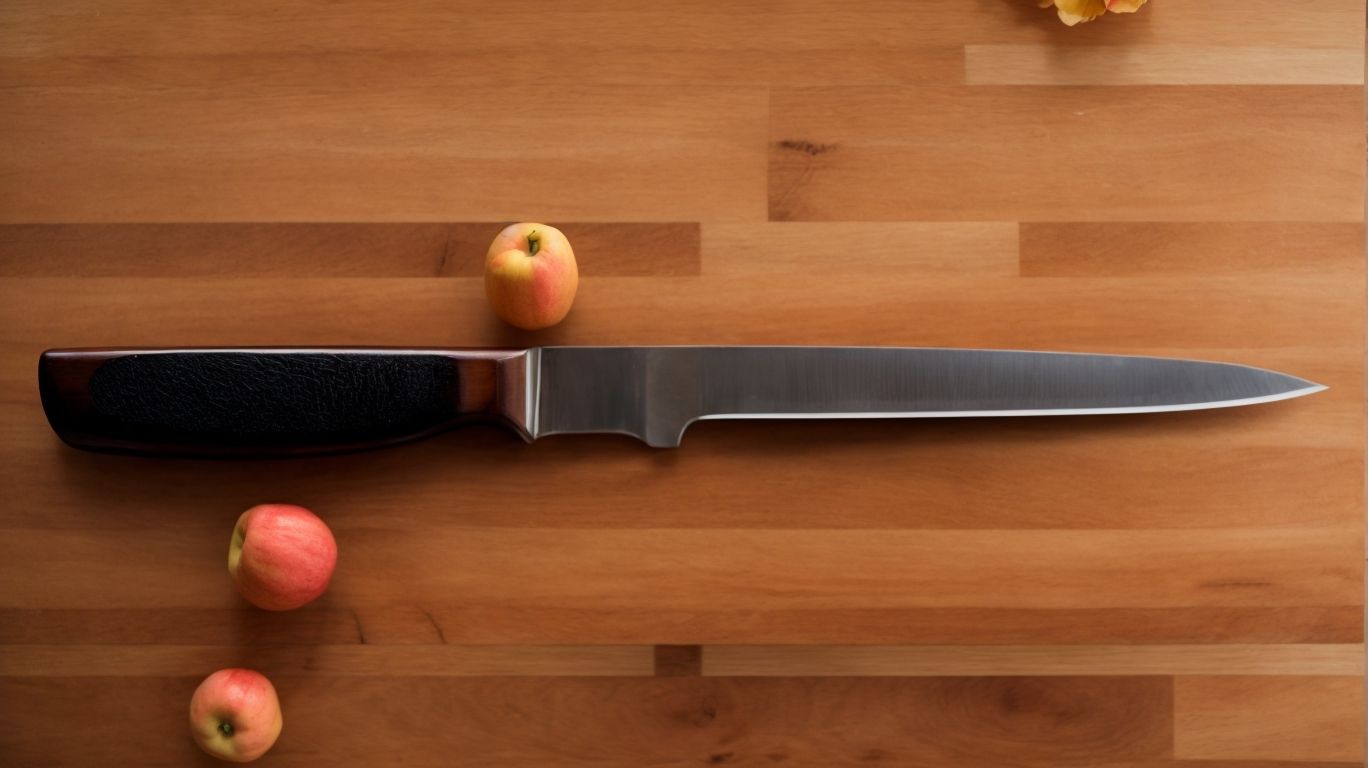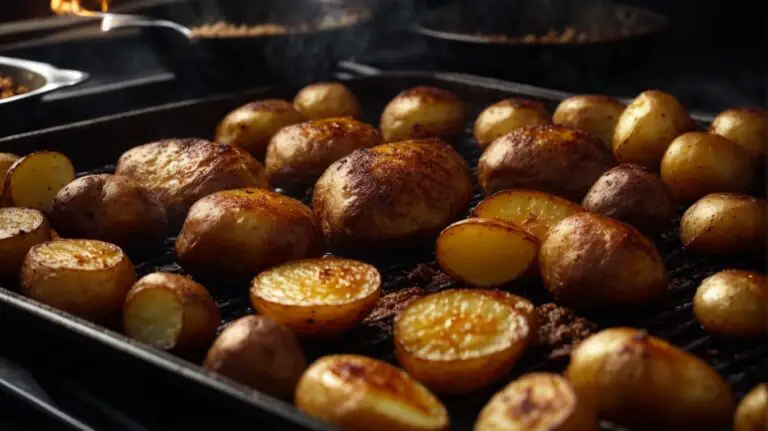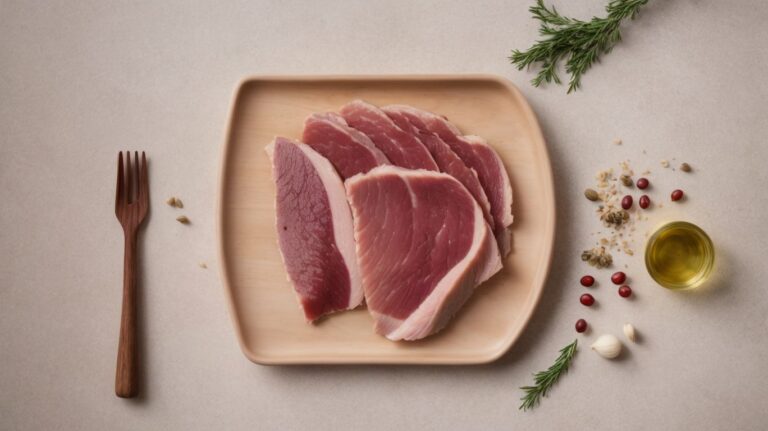How to Cook Quince Without Sugar?
Quince, a unique fruit with a delicate flavor, has been gaining popularity in the culinary world.
We will explore what quince is, where it is grown, and its nutritional benefits. We will also discuss why cooking quince without sugar is a great option, the health benefits of doing so, and how to prepare quince for cooking.
Discover 5 delicious sugar-free quince recipes and get tips for enhancing the natural sweetness of quince without using sugar. If you’re looking to elevate your cooking game, this article is a must-read!
Key Takeaways:
About Quince
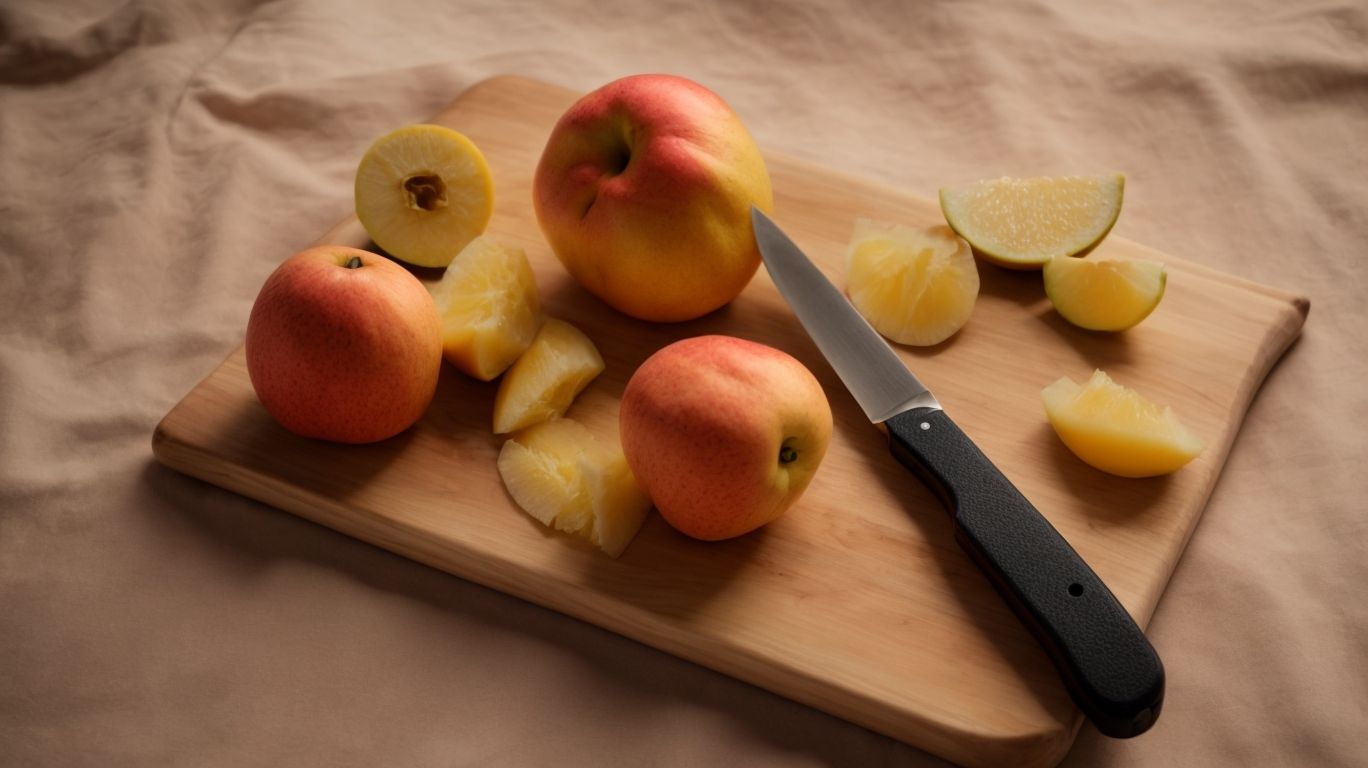
Credits: Poormet.Com – Logan Miller
Quince, a fruit with roots in Greece and Ancient Greek culinary traditions, holds a significant place in the world of cooking and baking.
Believed to have been cultivated in the Mediterranean region for thousands of years, quince was highly regarded by the Greeks as a symbol of love and fertility. In Ancient Greek mythology, quinces were associated with Aphrodite, the goddess of love, beauty, and fertility. The fruit was often depicted in art and literature as a token of love and happiness. Its unique fragrance and flavor made it a popular ingredient in various dishes and medicines during that era.
What Is Quince?
Quince, known for its unique flavor profile and aromatic qualities, serves as a versatile ingredient in various recipes, especially in baking, due to its rich mineral content.
Regarding taste, quinces offer a delightful combination of floral sweetness and subtle tartness, making them stand out among fruits. In baking, they are often used to make preserves, jams, jellies, and even tarts, adding a complex flavor to dishes. Their high pectin content also makes them ideal for creating thick, luscious textures in desserts. Apart from their culinary uses, quinces are packed with essential minerals such as iron, copper, and potassium, providing both flavor and nutritional benefits to the dishes they grace.
Where Is Quince Grown?
Quinces thrive in temperate climates, often harvested in autumn from quince trees, resembling a fusion of flavors reminiscent of pears, lemons, and a hint of autumnal aroma.
These unique fruits are mainly cultivated in regions with moderate temperatures and well-drained soil, making them prevalent in countries like Turkey, Iran, and Spain. The quince tree, which bears these delightful fruits, is known for its beautiful blossoms in spring, leading to the formation of the aromatic quince fruit. The seasonal availability of quinces adds to their allure, with their peak harvesting time coinciding with the arrival of autumn.
What Are the Nutritional Benefits of Quince?
Quinces offer a nutritional boost, containing essential minerals like zinc and copper, making them a healthy choice that can be sweetened naturally with maple syrup.
This unique fruit is a powerhouse of antioxidants, fibre, and vitamins C and A, all of which contribute to a strong immune system and healthy skin. Plus their nutritional value, quinces have also been linked to improved digestive health due to their high pectin content, aiding in digestion and promoting gut health.
Why Cook Quince Without Sugar?
Choosing to cook quince without sugar can offer various health benefits by reducing potential risks associated with excessive sugar consumption and promoting gut health through beneficial microbes.
Cooking quince without sugar allows you to enjoy the natural sweetness of this fruit without the negative impacts of added sugars. By avoiding added sugar, you can significantly lower your daily caloric intake and reduce the risk of health issues such as obesity, diabetes, and heart disease.
Quince is rich in fiber, vitamins, and antioxidants, which are essential for overall health and well-being. When prepared without sugar, quince retains its nutritional value and can contribute to a balanced diet that supports a strong immune system and healthy digestion.
The absence of sugar in cooked quince can positively impact gut health by promoting the growth of beneficial microbes. These microbes play a crucial role in digestion, nutrient absorption, and overall gut function, leading to better digestive health and potential protection against gastrointestinal disorders.
Is Quince Naturally Sweet?
While quinces possess a natural sweetness, they can be enhanced with a touch of honey, adding depth to their aroma and flavor profile.
Quinces, often described as a combination of flavors reminiscent of apples, pears, and guavas, offer a unique taste experience that sets them apart from other fruits. The addition of honey not only intensifies their inherent sweetness but also harmonizes with their slightly tart undertones, resulting in a delightful balance of flavors.
The aromatic qualities of quinces, with hints of floral notes and a subtle earthiness, further elevate their complexity, making them a favorite for culinary creations ranging from jams and jellies to sauces and desserts.
What Are the Health Benefits of Cooking Quince Without Sugar?
Cooking quince without sugar not only reduces sugar intake but also unlocks the health benefits of pectin found in quinces, offering a nutritious alternative for health-conscious individuals.
Quinces, known for their distinct aroma and sweet-tart flavor, are a rich source of vitamin C, fiber, and antioxidants. By preparing quince without sugar, you can retain these valuable nutrients without the added sugars that can lead to various health issues. Pectin, a soluble fiber present in quinces, aids in digestion, helps lower cholesterol levels, and promotes gut health.
Reducing sugar consumption is a vital aspect of maintaining overall health, as excessive sugar intake has been linked to obesity, diabetes, and heart disease. Choosing to cook quince without sugar not only offers a delicious treat but also aligns with a balanced diet and healthier lifestyle.
How to Prepare Quince for Cooking
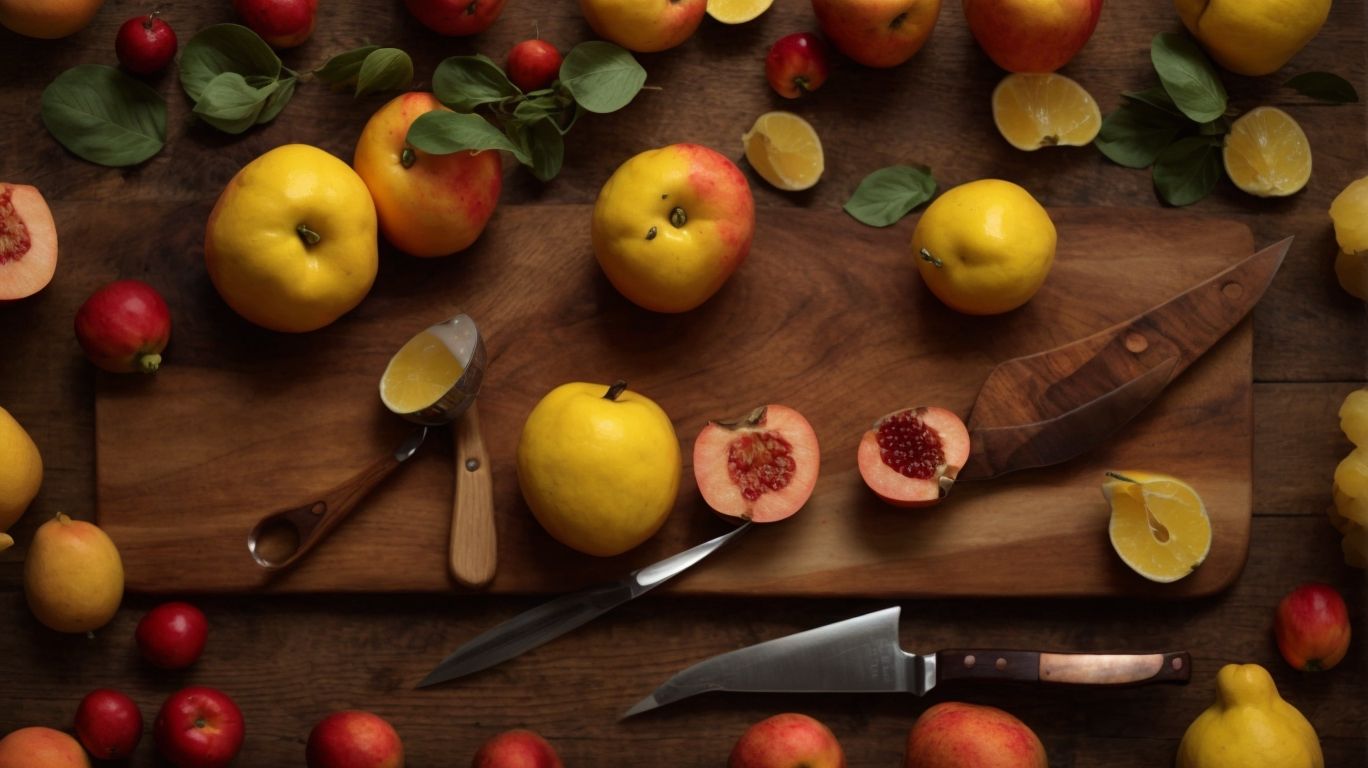
Credits: Poormet.Com – Willie Thomas
Preparing quince for cooking involves careful coring, slicing, and possibly roasting with almonds in the oven to enhance their natural flavors and textures.
To start preparing quinces for cooking, wash and scrub them to remove any dirt or residue. Next, using a sharp knife, slice off the top and bottom of the quince to create a stable base. Then, take the knife and carefully core the quince, removing the seeds and tough inner flesh.
Once the quince is cored, you can proceed to slice it into desired shapes, such as wedges or cubes, depending on your recipe’s requirements. For a delightful twist, consider roasting the quince with a sprinkle of sliced almonds in the oven. This not only adds a crunchy texture but also brings out the sweet and tangy flavors of the fruit.
What Are the Steps to Prepare Quince for Cooking?
To prepare quince for cooking, follow a detailed recipe and step-by-step instructions to create a delightful quince paste or other culinary wonders.
Begin by selecting ripe, fragrant quinces with a golden yellow hue and a slight fuzz on the skin. Wash the quinces thoroughly to remove any dirt or residue.
Next, carefully peel the quinces using a sharp knife or vegetable peeler, ensuring to remove the tough outer layer while keeping the flesh intact. Cut the quinces into quarters or slices, depending on your recipe requirements.
- Poach the quince pieces in a syrup made from water, sugar, and aromatic spices like cinnamon and cloves. Simmer gently until the quinces are tender and have absorbed the flavors of the syrup.
What Are the Best Cooking Methods for Quince?
Exploring traditional methods like creating quince paste can showcase the versatility of quinces and introduce delightful recipes that honor culinary traditions.
Quinces, with their unique flavor profile that combines sweetness and tartness, are perfect for creating a luscious quince paste. To make this delicacy, start by simmering peeled, cored, and chopped quinces with sugar and a hint of lemon juice until they soften and turn into a thick, amber-colored paste. The slow cooking process allows the flavors to intensify, resulting in a spread that pairs wonderfully with cheese platters or as a filling for pastries.
5 Delicious Sugar-Free Quince Recipes
Indulge in the delightful world of sugar-free quince recipes, from jams to Kidonopasto and Membrillo, all showcasing the natural pectin-rich goodness of quinces.
Quinces, with their unique aroma and flavor, lend themselves beautifully to various culinary creations. The high pectin content in quinces makes them ideal for setting jams and jellies without the need for additional sugars. For a breakfast treat, try spreading a spoonful of homemade quince jam on warm toast or using it as a filling for pastries.
One of the most popular quince-based delights is Kidonopasto, a sweet jelly-like treat enjoyed on its own or paired with cheese and crackers for a delightful appetizer. Membrillo, a firm paste made from quince, is a versatile accompaniment to cheese platters, adding a sweet and tangy contrast.
Quince and Chicken Stew
The savory blend of quince and chicken in a hearty stew offers a unique culinary experience that tantalizes the taste buds, perfect for a cozy winter evening.
If you want to recreate this delightful dish in your own kitchen, here’s a simple yet delicious recipe to get you started. Begin by preparing your ingredients – fresh quinces, tender chicken pieces, aromatic herbs like thyme and parsley, and a medley of vegetables such as carrots and potatoes.
Quinces are a beautifully fragrant fruit that adds a subtle sweetness to the stew, complementing the savory flavor of the tender chicken. The stew simmers slowly on the stove, allowing the flavors to meld together, creating a rich and comforting dish that warms you from the inside out. Serve the quince and chicken stew piping hot for a satisfying meal that is bound to become a seasonal favorite.
Quince and Goat Cheese Salad
Elevate your salad game with a refreshing Quince and Goat Cheese combination, featuring a medley of fresh ingredients that harmonize beautifully on the plate.
Begin this tantalizing journey by selecting ripe quinces, known for their sweet and tangy flavor profile that adds a unique twist to traditional salads. The creamy goat cheese complements the quince perfectly, balancing out the dish with its rich and slightly tangy undertones.
Enhance the vibrancy of this salad with a bed of vibrant mixed greens, providing a crisp texture that contrasts wonderfully with the soft quince and creamy cheese.
To create a burst of freshness, toss in some toasted walnuts, adding a delightful crunch and nutty flavor that elevates each bite to new heights. Drizzle a balsamic reduction over the salad, enhancing the overall taste with a sweet and tangy finish.
Quince and Mushroom Risotto
Experience a symphony of flavors with the Quince and Mushroom Risotto, a luxurious dish that marries the earthiness of mushrooms with the sweet tang of quinces.
As the risotto slowly simmers, the fragrant scent of the Arborio rice mingling with the sautéed mushrooms fills the kitchen, creating an anticipation for the culinary delight to come. The rich umami notes from the mushrooms combine harmoniously with the delicate sweetness of the quinces, enhancing the overall depth of the dish. Each spoonful of this velvety risotto offers a perfect balance of textures, from the creamy rice to the tender mushrooms, with occasional bursts of fruity brightness from the quince. The finishing touch of Parmesan cheese adds a luxurious creaminess that ties all the flavors together beautifully.
Quince and Pork Tenderloin
Delight your senses with the succulent Quince and Pork Tenderloin dish, where the sweet notes of quinces complement the savory goodness of tender pork, enhanced by a touch of maple syrup.
Quinces, with their fragrant aroma and unique flavor, add a delightful twist to this classic pork dish. The natural sweetness of quinces caramelizes beautifully when paired with the maple syrup, creating a luscious glaze that coats the tender pork tenderloin. The combination of flavors is a harmonious marriage of sweet and savory, making each bite a flavorful experience.
To prepare this delectable dish, begin by marinating the pork tenderloin in a mixture of maple syrup, garlic, rosemary, and black pepper. Allow the flavors to meld together for at least an hour to infuse the meat with a rich, aromatic profile.
Meanwhile, prepare the quinces by peeling and slicing them into wedges. Sauté the quince slices in a pan until they are caramelized and tender, adding a drizzle of maple syrup for that extra touch of sweetness.
Quince and Yogurt Parfait
Indulge in a wholesome Quince and Yogurt Parfait that balances the natural sweetness of quinces with the creamy goodness of yogurt, offering a guilt-free treat without the health risks of added sugars.
Quinces, a fruit rich in fiber and antioxidants, are not only delicious but also contribute to better digestion and overall health. When combined with probiotic-rich yogurt, this parfait becomes a powerhouse of gut-friendly nutrients that support a healthy digestive system. The refreshing and light taste of the parfait makes it a perfect option for a satisfying dessert or even a nourishing breakfast. The low-calorie content of quinces and yogurt makes this treat ideal for those watching their weight or trying to maintain a balanced diet.
Tips for Cooking with Quince Without Sugar
Enhance the natural sweetness of quince-based dishes with a hint of honey, elevating the flavors to a delightful balance that captures the essence of pear-like undertones.
When cooking with quinces without sugar, consider using honey as a natural sweetener to complement the inherent flavors. Quinces, known for their aromatic and slightly tart taste, can benefit greatly from the addition of honey. Pairing these fruits together not only adds a gentle sweetness but also brings out the pear-like undertones, creating a harmonious blend of flavors.
Experiment with different types of honey to further enhance the complexity of your quince dishes. From the floral notes of acacia honey to the rich flavors of chestnut honey, each variety can add a unique touch to your recipes. Remember to adjust the amount of honey based on your desired level of sweetness, allowing the quince’s natural taste to shine through.
How to Enhance the Natural Sweetness of Quince?
Discover creative ways to enhance the natural sweetness of quinces by incorporating complementary flavors like pear, lemon, or even a hint of peach or rose-oil for a unique culinary experience.
Quinces, with their aromatic and slightly tart flavor, can be elevated to new heights when paired with these exquisite flavors. For a delightful twist, try adding a splash of pear juice to quince jam to enhance its fruity notes. Alternatively, infuse quince compote with a touch of lemon zest for a refreshing citrusy kick. To create a luxurious dessert, consider drizzling poached quinces with a delicate rose-oil syrup, adding a floral essence that complements the quince’s natural sweetness. These flavor pairings open up a world of culinary possibilities, transforming quinces into a gourmet delight.
What Are Some Alternative Sweeteners to Sugar for Cooking with Quince?
Explore a world of alternative sweeteners for cooking with quinces, from traditional options like dulce de membrillo to international delights like marmelada, pâte de coing, and cotognata.
Quinces, with their unique floral aroma and firm texture, offer a perfect canvas for experimenting with a range of sweeteners. Beyond the classics, there are also modern twists like agave nectar, stevia, and monk fruit extract that can add nuanced flavors to your quince creations. Whether you’re looking for a bold and rich sweetness or a subtle enhancement, the world of sweeteners is vast and diverse, providing endless possibilities to elevate your quince recipes. Embrace the art of pairing different sweeteners with quinces to unlock a world of culinary creativity.
Frequently Asked Questions
Question: Can I cook quince without using sugar?
Yes, you can cook quince without using sugar. In fact, there are several delicious and healthy ways to prepare this fruit without adding any sugar.
Question: What are some alternative sweeteners I can use when cooking quince?
Instead of sugar, you can use natural sweeteners like honey, maple syrup, agave nectar, or simply use the natural sweetness of the quince itself.
Question: How can I enhance the flavor of quince without sugar?
You can enhance the flavor of quince by adding spices like cinnamon, cloves, or cardamom. You can also add citrus fruits like lemon or orange to give it a tangy twist.
Question: Can I use quince in savory dishes without sugar?
Absolutely! Quince can be used in savory dishes such as stews, tagines, or roasted with vegetables. Its slightly tart flavor pairs well with savory ingredients.
Question: What is the best way to cook quince without sugar?
The best way to cook quince without sugar is by poaching it in water or fruit juice. This method allows the natural sweetness of the quince to come through without the need for added sugar.
Question: Are there any health benefits to cooking quince without sugar?
Yes, cooking quince without sugar can be a healthier option as it reduces the overall sugar content in your diet. Quince is also a good source of dietary fiber, vitamins, and minerals, making it a nutritious addition to your meals.

